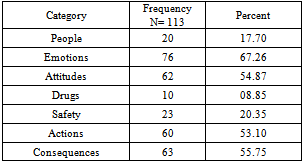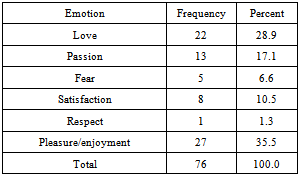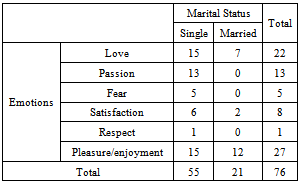-
Paper Information
- Previous Paper
- Paper Submission
-
Journal Information
- About This Journal
- Editorial Board
- Current Issue
- Archive
- Author Guidelines
- Contact Us
International Journal of Applied Psychology
2012; 2(3): 31-35
doi: 10.5923/j.ijap.20120203.03
Assessing Young Peoples’ Momentary Thoughts About Sex: A Proposal of the Sex Envelope Game
Anthony M. Ireri1, Philomena N. Mathuvi2, Amos M. Njagi1, Eric G. Mwenda3, Haniel N. Gatumu4, Joan M. Njagi5, Mathew N. Piero6, Njagi I. Karugu7
1Department of Educational Psychology, Kenyatta University. Nairobi, P.O. Box, 43844, 00100, Kenya
2Department of Kiswahili, Kenyatta University. Nairobi, P.O. Box, 43844, 00100, Kenya
3Department of Education, Kenya Methodist University, Nyeri, P.O. Box 2285, 10140, Kenya
4Department of Psychology, University of Nairobi. Nairobi, P.O. Box 30197, 0010,Kenya
5Department of Environmental Health, Kenyatta University. Nairobi, P.O. Box, 43844, 00100, Kenya
6Department of Biochemistry & Biotechnology, Kenyatta University. Nairobi, P.O. Box, 43844, 00100, Kenya
7Department of Education, Chuka University College, Chuka, P.O. Box, 104258, 00100, Kenya
Correspondence to: Anthony M. Ireri, Department of Educational Psychology, Kenyatta University. Nairobi, P.O. Box, 43844, 00100, Kenya.
| Email: |  |
Copyright © 2012 Scientific & Academic Publishing. All Rights Reserved.
Most sexual reproductive health programmes for young people in developing countries depend on foreign concepts and data ignoring potential local strategies. Finding more effective ways for needs assessment and to engage young people in sexual health discussions is essential. Owing to the lack of research tools to investigate young people’s thoughts about sex, this paper proposes the sex envelope game based on results of a study conducted in Kenya among 113 participants (average age=23.9 years, Sd., 3.9). Results indicate that the simple method of the sex envelope game elicits important information regarding adolescents’ thoughts about sex. Areas of further research are suggested.
Keywords: Young People, Thoughts, Sex Envelope Game
Article Outline
1. Introduction
- Young people’s sexual reproductive health is a key target for numerous programmes worldwide. A key expectation of such programmes for young people is that they should start with context-specific needs assessment. This usually involves finding out what young people believe, think and feel about a particular issue, as well as what they do[1]. However, fallacies and stereotypes that characterize professional and lay understanding of young people’s sexuality continue to be relied upon when planning for young people’s sexual and reproductive health needs in some of the existing programmes. According to the Kenya Bureau of statistics[2] young people’s reproductive health is now a priority in Kenya at a policy level, as attested to by the recent sessional papers on AIDS as well as the national Information, Education, Communication, and Advocacy Strategy. What young people think about issues related to their sexuality is often ignored in many sexual health programmes, especially in developing countires. This may compromise the applicability of existing context-specific research findings to more general cross-cultural populations[3].From the social constructionist perspective, the specific meanings attached to sexuality must be examined at particular historical moments in particular cultures. Young adulthood presents the challenge of increased decision-making, for example, which friends to choose, which person to date, whether to have sex, whether to choose immediate satisfaction or delay satisfaction for a positive outcome and so on[4]. Nudelman[5] argues that although young people basically experience similar challenges, it is important to recognize that perhaps sexual attitudes and experiences vary between ethnic groups. Since young adulthood is a time of extreme introspection and differences exist in how young men and women experience improved feelings of body satisfaction and self-assurance in this developmental stage[6], we need to adapt effective strategies while trying to understand and guide our young people.In Kenya, the socialization process of young people within gender identities and stereotypes from early childhood impart different gender identities and also determine the relatively different sexual scripts for boys and girls[7, 8]. For example, differences among Kenyan men and women have been observed especially in the age of sexual debut. Women and men aged 20-49 are reported to debut sex before age 15. Further, in rural areas young people start sexual activity about 2 years earlier than their urban counterparts[9]. Younger Kenyan men have also been found to initiate sex much earlier than girls with some starting as early as at age 6[10].Studies conducted among young people in Kenya indicate gender differences in their sexual behaviour. For example, Kuta[11] found that more girls than boys had sex with more than one partner and that there were gender differences in students’ ability to communicate about their life, body and feelings. Kimani[10] involved 229 form three students in a study about factors influencing adolescent precocity to sexual practice in selected secondary schools in Nairobi. The self-reported data indicate that mass media, peer influence, access to drugs and alcohol and extreme sex drive were major factors responsible for adolescent precocity in sexual matters. Among the students, gender differences were also observed in terms of sources of information about sex. The most critical factor identified was peer influence followed by mass media.Other studies have also identified peer pressure as a reason for engaging in sexual activities. Contrary to popular belief, Ndayala[12] found no relationship between adolescents’ attitudes towards sex and their sexual decisions. May be the answer to this contradiction would be an understanding of what young people think about when they hear the word sex. Moreover, the available research has rarely given young people an opportunity to describe their thoughts about sex. We contend that the reported gender differences in sexual behaviour may imply differences in the thoughts that young people have towards sex.In many African cultures, talking about sex and sexuality to young people is often a tabooed. Such taboos often call for the use of unconventional methods in teaching reproductive health to young people or when talking about the tabooed topics in public. Teaching about such topics takes courage and preparation[7, 8]. The greatest challenge for the existing programmes is that youth do not always seem interested in focusing on the “distant” health consequences of their actions[13].Irvine[14] asserts that the meanings teenagers attach to sexuality and relationships vary according to different messages and imperatives from their myriad social worlds. The social contexts also influence young people’s thoughts[15]. A study among Ethiopian immigrant adolescents established that love, trust (classified as emotions in our study) and sexual activity were considered as important qualities in a steady romantic relationship[16]. In contrast, Kenyan adolescents deem peer acceptance and appreciation of the partner by parents to be more important[10]. In contexts where mood-altering substances and peers engaging in risk taking situations are readily available, young people are likely to harbor risky thoughts[17, 18].Social learning theory predicts that young people who watch portrayals of sex without consequences are more likely to become sexually active and this may be reflected in the young people’s thoughts[19]. Similarly, according to the cognitive perspective on motivation, young people’s thoughts guide their motivation to engage in behaviour[20]. Thoughts have also been shown to influence our behaviour in the rational reasoning models of behaviour[21]. Further, by analyzing data on attitudes and intentions related to abstinence and sex among 365 adolescents aged 12–15 in the USA, a study found that sex cognitions accounted for substantially more variation in sexual activity than did one including only abstinence cognitions (15–26% vs. 6–8%)[22]. Therefore, understanding more about young people’s thoughts about sex could provide the critical first step in designing future interventions to increase safe sex practice.Several models have been proposed to address issues regarding young people’s sexuality. A good example is the comprehensive educational model which addresses gender stereotypes and sexual abuse, while focusing on life skills development and personal empowerment. It is intended to develop culturally-sensitive interventions for adolescent sexual reproductive health that are informed by adolescents’ thoughts about their health[5]. However, such a model may fail to build interest and curiosity and allow learners to work through the content themselves if its methods don’t encourage learners from different cultural backgrounds to identify with the information on their sexuality.The dual-process model has been proposed to explain young people’s decision-making[6]. This model states that decision-making is influenced by two cognitive systems, one analytical and one experiential which compete with each other[23]. The model emphasizes that it is the experiential system- monitoring and managing actual experiences that benefits young people’s decision making[6]. In this view, young people do not benefit from engaging in reflective detailed higher-level cognitive analysis about a decision, especially in high-risk real world contexts. It is further argued that most people make adaptive decisions when they are calm rather than when they are emotionally aroused, which may especially be true for young adults[24]. Sex is emotionally arousing and we expect even young people who make wise decisions when calm to have some maladaptive thoughts about it[25]. With the current proliferation of sexual information and images on the media, we may want to know just what young people think about when they hear the word sex.Currently, there appears to be few tools available to enable Kenyan adolescents discuss their thoughts about sex in a relaxed and playful way. Since games have been found to allow individuals to work in their own style of learning and to encourage meaningful engagement in adolescent reproductive health matters[13] we sought to explore such a tool using plain envelopes and slips of paper.
2. Methodology
2.1. Participants
- 113 participants were in the study (67 male and 46 female). The average age was 23.9 years with a standard deviation of 3.9. (Male 23.33 years, sd 3.72; Female: 22.72 years, Sd 4.16). The participants were members of performing groups from Nyeri and Kirinyaga Counties of Central Kenya. The sample was considered appropriate for the study on thoughts about sex since in Central Province, women and men aged 20-49 debut sex at the age of 18.6 and 18.5 respectively[9].
2.2. Data Collection.
- Each participant was given a blank white A6 envelope containing 3 slips of white paper. They were instructed to write their age, gender, marital status and the highest level of education at the top of the envelope. The participants were instructed that they would be timed for the exercise. They were then instructed to remove the slips of paper from the envelope and told to write three things that they thought about when they heard the word “sex”. Each of the three things was to be written on a separate slip. They were given only a minute to complete the task after which they were to insert their slips back into the envelope and the researchers put all the envelopes into a carton. The participants were not informed about the purpose of the game before completing the exercise. After the game, the researcher collected participants’ views on what they thought the purpose of the game was after which they were debriefed and any fears clarified by the researcher[26].
2.3. Analyses
- First, the envelopes were opened and the written slips sorted out. Key categories were identified by reading the paper slips one by one and recording on a separate sheet with codes that described the content of the responses[26]. Codes were entered as labels that describe the broad categories based on popular issues young people have regarding sex thus: people, emotions, attitudes, drugs, safety, actions, and consequences. The coded data were then analyzed using SPSS. The frequencies for each category are given below.
3. Results and Discussion
|
|
|
|
4. Limitations
- Several important limitations to this study must be noted. Although the sample used in this study was reasonably large, it is difficult to generalize the perceptions of our study sample to young people from the wider Kenyan population. Secondly, questions relating to one’s thoughts about sex may be subject to seasonal bias and social desirability bias owing to the privacy given to these issues in many Kenyan societies. It is important to note that the data was collected among young people who were members of performing groups from areas in Central Province. Group membership may have equipped them with self-expression skills that may have made their responses to be quite different from what other young people may have given. The data presented here may not represent the thought patterns of young people who are non-members of performing groups.Although using the game to engage young people provided insight into their thoughts and feelings, it raised methodological concerns. For example, it could be argued that the group setting for game can perpetuate conformity and the repetition of similar ideas[13, 30]. However, we argue that the power of the game in eliciting honest opinions lies in the fact that the participants were not informed of the purpose of the game until it was over. It was also cumbersome sorting out the written slips as some participants gave synonyms as distinct thoughts.The research took place in a workshop setting, and this may have created a ‘power difference’ between the researcher and participants. However, although the exercise bore some resemblance to everyday group activities, the researcher made an effort to create an environment that was non-threatening, confidential and stimulated the freedom to talk openly among participants. Finally, a broad approach was taken in this study in order to identify the key issues around modern young people’s thoughts about sex.
5. Conclusions
- The study results indicate a simple game like the sex envelope game can be useful in assessing what young people think about when they hear about sex. This is an important aspect of inquiry since our young people are constantly bombarded with sexual messages on the media.We suggest that similar studies be carried out with young people from different cultures to ascertain the applicability of this simple but highly promising method of inquiry into momentary thoughts. The game may also be applied to investigate other pertinent areas of young people’s sexual reproductive and mental health. The use of the method alongside other methods of inquiry may help in establishing its validity. We also propose that the tool be used in a comparative study involving children, adolescent and older populations to establish its use in mapping out age and gender differences in what people think about when they hear the word sex.Further work will be needed to provide greater detail on some of the emergent themes, such as the type of actions commonly thought of at the mention of sex and the motivations behind young people’s thoughts of those actions, importance of those actions, and the people they engage in the actions with. To overcome the limitation of the game in terms of language, we propose that it be tried out using Kiswahili or other local dialects.
 Abstract
Abstract Reference
Reference Full-Text PDF
Full-Text PDF Full-Text HTML
Full-Text HTML


